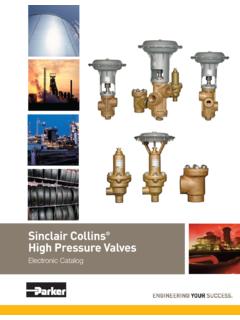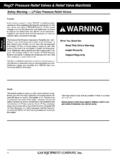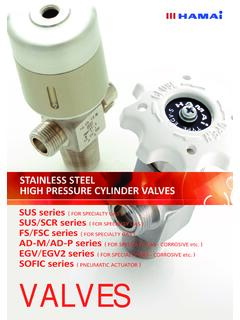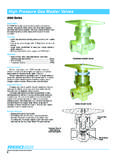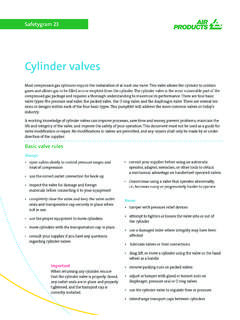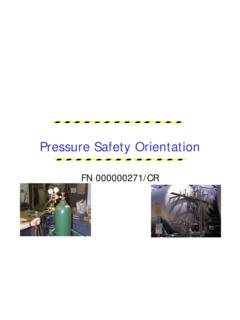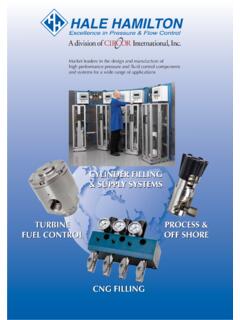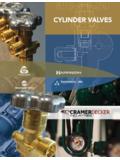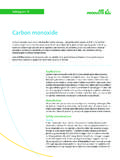Transcription of How to select a counterbalance valve - Eaton
1 IntroductionCounterbalance valves play an integral role in the important task of safely controlling an actuator which may be holding a load or a person in the air. They help manage pressure created by impacts and loads to help stabilize loads, avoid equipment damage, and cope with hose failure and runaway loadsStandard counterbalance valves help prevent static or dynamic loads from uncontrolled or uninitiated induced pressureIn applications where pressure spikes are created by the operation of the machine, part-balanced counterbalance valves help avoid equipment damage by allowing line relief valves to operate high or variable back pressureFully-balanced relief valves help stabilize systems that have very high or experience large variations in back for high system instabilityTwo-stage valves create stability in machinery with high intrinsic hose burst protectionBoomLoc valves play a role in raising and lowering loads, and limit load speed in cases of hose of the above will hold the load, control the load and provide load safety in the event of hose criteriaWhen selecting counterbalance valves .
2 Hydraulics engineers are faced with a difficult but important task. These small valves provide an important safety function in applications where safe and stable load handling is critical. They are often asked to deal with high pressure , large flows or operate in extreme environments. Reducing instability can improve productivity and safety in an array of hydraulic systems. Choosing the perfect counterbalance valve for these dynamic systems presents a challenging task. There are many options, and few people really understand them all. This has led people to select a valve from a familiar supplier without really questioning or understanding their choice or the options they can help solve this problem with the broadest portfolio of counterbalance valves in the industry.
3 This will control costs while helping you find the best valve or the to select a counterbalance valveMatt DeBruine, Global planning & strategy manager Screw-in cartridge valves , EatonEaton counterbalance valvesEaton counterbalance valvesWhat function do load holding valves provide?To understand how to apply a counterbalance valve , it s important to understand how they work. counterbalance valves , when placed between a directional control and the head or rod end of a cylinder , play an integral role in the important task of safely controlling an actuator which may be holding a load or a person in the work in three distinct ways to ensure success while raising, lowering, and holding loads during linear or rotary Load holding: counterbalance valves prevent the cylinder from unwanted downward drift.
4 This function is referred to load holding and is critically important in aerial work platforms. The valve allows operators to raise or lower the boom at their desired rate and hold it in position. The load is raised through an integral free flow check which allows flow from the directional valves to the cylinder , but prevents flow in the reverse Load control: counterbalance valves also control loads by prevent-ing actuators from running ahead of the pump due to energy created by the load. This function prevents loss of control and damage to the actuator caused by Load Safety: Finally, in cases where a line breaks, a load holding valve directly mounted to the actuator will prevent uncontrolled and unsafe load does the relief valves provide counterbalance to the actuator?
5 A counterbalance valve can easily be described as a pilot operated relief valve with a free flow check. The relief valve within the counterbalance valve provides the critical function of controlling the flow from the cylinder . The relief valve opens when the combined force created by the pilot pressure and the load-induced pressure exceeds the relief setting (typically times the maximum load pressure ).The valve continually meters flow and controls descent. If the load begins to run away or shows signs of instability, the pressure in the pilot line will fall, causing the valve to restrict the flow exiting the actuator and preventing load runaway.
6 In the following pages, we will take a look at various tasks that can be performed by counterbalance valves , specific applications in which different valve types may be used, and the types of valves best suited to each counterbalance applicationStandard counterbalance valve ( Eaton 1CE)For most applications. the most cost effective solution is to use the basic load holding valve such as the Eaton 1CE series. These valves are suitable for use with static or dynamic loads when trying to stop a load from drifting or running common example is a cherry picker, where the load is often a person. The basic task is to raise and hold the person in the air for a period of time while work is being performed.
7 Then return them safely to the ground. If instability is occurring while using a standard counterbalance valve , consider changing the valve s pilot ratio. Most counterbalance valves are available with a variety of pilot ratios and are interchangeable, making it easy to find the correct ratio for the a pilot ratioIn general, higher pilot ratios work well for consistent, stable loads and lower pilot ratios for unstable or variable loads. The pilot ratio does not necessarily have a substantial impact on the working pressure , because the normal working pressure for a system is often higher than the pilot pressure required to open the valve graph below shows the pilot pressure required to open the valve at a given set pressure and a varying load pressure with different pilot ratiosLoad pressureLoad pressureSet pressure10 to 1 Pilot ratio5 to 1 Pilot to 1 Pilot ratioPilot pressure required for opening05010 0150200250 Instability results from rapid changes in the load pressure .
8 In the chart above, you can see how a lower pilot ratio valve ( to 1) has greater sensitivity to changes in the load pressure . In other words, if the load pressure suddenly increases, the operator will have to apply additional pilot pressure . A higher pilot ratio valve , with a flatter response, is more likely to open quickly when a sudden increase in load pressure the unlikely event that instability is still evident, by either audible squealing or bounce on initial movement, you may need to consider changing the valve design type. These are interchangeable making it easy to retrofit into the actuator or types of relief function in counterbalance valvesIf squealing is an issue, it may be the result of the construction of the relief valve within the counterbalance are two main types of construction available in the market today: direct acting and differential area.
9 The direct acting valve is based on the simplest form of relief valve design and provides stability through a wide range of pressures and flows. Eaton s 1CE series valves are an example of how the direct acting construction provides improved stability over the differential area version of the acting valves take their name from the fact that the load pressure acts on the full area of the style is a proven, simple, and traditional relief valve design. Because the pressure is applied to a large poppet area, greater spring force is required to meter and reseat the poppet. This spring force plays an important role in the metering of flow or what we refer to as the relief characteristic of the counterbalance Direct acting vs.
10 Differential areaIn contrast to direct acting valves , differential area designs are also available and widely used in the market place. They work by applying load pressure to a differential area between the poppet and the seat. This creates a smaller area for the load pressure to act the poppet area is smaller with a differential area design, for a given load pressure , the poppet will require less spring force to meter and close the valve . This results in a valve that can meter large amounts of flow very rapidly. While this can be beneficial when dealing with very high flow applications, it can lead to instability and squealing in typical moderate flow hydraulic acting valves are more stable because the heavier spring makes the poppet less reactive to small fluctuations in load pressure .










